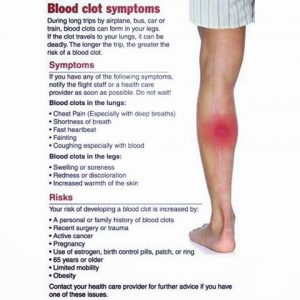According to the National Blood Clot Alliance, 274 people will die every day from the consequences of a blood clot. Neither age nor gender offer protection: you can develop a clot just as easily at 25 years of age as 85 years of age. Most are the result of a traumatic injury, a surgical complication or due to taking hormone replacement therapy. Some birth control medications also present an increased risk of blood clots in susceptible patients.
A thrombosis is a blood clot that blocks the normal flow of blood through an artery or vein. A deep vein thrombosis (DVT) occurs in the deeper veins-for example in the lower leg or calf. However, thromboses can occur anywhere in the body including the upper limbs (arms). The latter are much less frequent: 10% of all DVTs are found in the upper limb and usually result from the use of catheters; surgery or trauma to the neck or shoulder.
Even sitting for long periods of time at work or at home in front of the computer can cause a DVT. Long plane flights, particularly if you have taken a sedative or sleeping pill and don’t move during the flight, pose a real risk for deep vein thrombosis. You should be certain to get up out of a seat, either in front of your computer or on an airplane, at least every two hours. If you must work at home, consider placing your printer across the room from your computer so that you have to get up to retrieve printed material. Doctor Legato has deliberately chosen not to keep her printer nearby for that very reason.
The risks from DVTs vary and can include tissue necrosis (tissue death), swelling and pain. The most important risk occurs when part of the clot breaks off and travels to the lung or brain. The resulting damage is always significant and may lead to sudden death.
Symptoms of a DVT in the leg include swelling and cramping pain or soreness in the calf muscles. The skin over the area can become reddened or warm to the touch because of the underlying inflammation.
DVTs can also occur without warning and without noticeable symptoms. Sometimes they resolve on their own. However, if you develop signs or symptoms of deep vein thrombosis, contact your doctor, who will order an ultrasound examination of the area and prescribe blood thinners. If you think you might have a problem, do not delay; see your physician at once or go to an emergency room for examination.
The warning signs and symptoms of a pulmonary embolism (or clot to the lung) include:
- Shortness of breath that is sudden and unaccountable
- Chest pain or discomfort that visibly worsens when you inhale deeply or when you cough
- Feeling lightheaded and/or dizzy, or fainting
- Fast heartbeat or rapid pulse
- Coughing up blood
Finally, there are some preventative measures if you feel you are at risk. Doctor Legato advises patients who are immobile or who travel frequently to try and exercise on a regular basis and avoid sitting still for long periods of time. It’s also important to avoid crossing your legs, which can block blood flow. She suggests that “If you’re traveling by car, stop every 45 minutes to an hour and walk around. If you’re on a plane, stand, stretch and walk up and down the aisle. If you can’t do that, exercise your lower legs by raising and lowering your heels while keeping your toes on the floor, then raising your toes while your heels are on the floor. You can also rotate your feet in a circular motion. All of these movements can keep your blood circulating.”
DVTs are more common than we realize but don’t have to be deadly, if we pay attention to our bodies and take preventative measures whenever possible.

Strategic Communications Professional/Content Strategist/Marketing Communications Consultant





